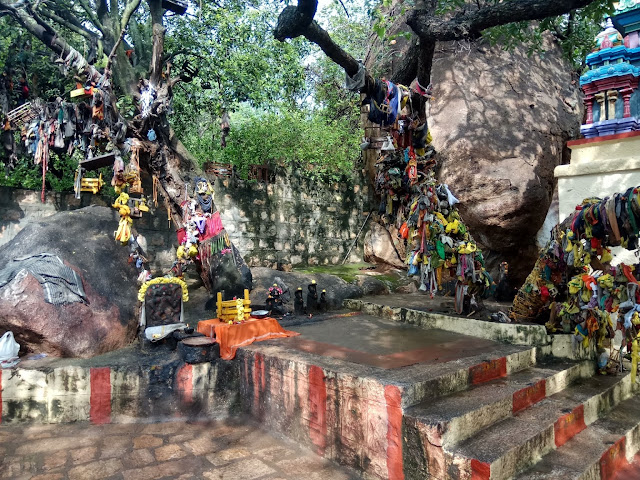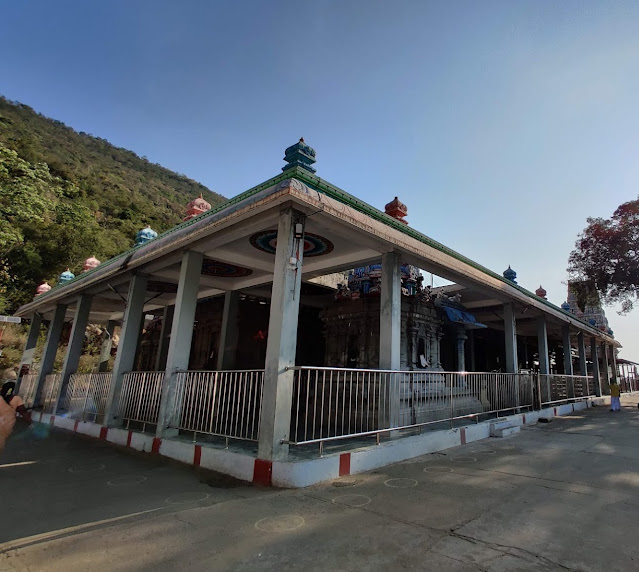Marudamalai Murugan Temple, Coimbatore
Marudamalai Murugan Temple is a Hindu Temple
dedicated to Lord Murugan located in Marudamalai in Coimbatore North Taluk in Coimbatore District of Tamil Nadu, India. The temple is situated at the
top of a 600 feet tall hill on the western ghats. The temple is situated on the
eastern face of the hill compare to the other Murugan temples on the hills. The
temple is considered one among the Thirupugazh Sthalams and regarded as the seventh
army camp (Padaiveedu) of Lord Muruga.
Legends
For brief details, please refer below link;
https://tamilnadu-favtourism.blogspot.com/2025/07/marudamalai-murugan-temple-legends.html
History
The original temple was built by the Tamil Kings of Sangam period as indicated in the Purananuru. The inscriptions found in Thirumuruganatha Swamy Temple, Thirumuruganpoondi places the origin of the temple in the 12th century CE. M. M. A. Chinnappa Thevar, famous yesteryear filmmaker made several contributions for the betterment of this temple.
The Temple Complex
For brief details, please refer below link;
https://tamilnadu-favtourism.blogspot.com/2025/07/marudamalai-murugan-temple-temple-complex.html
Temple Opening Time
The temple remains open from 05.30
a.m. to 01.00 p.m. and 02.00 p.m.to 08.30 p.m.
Pooja Timings
|
1 |
Viswaroopa Dharsanam (Usha Kalam) |
6.00
A.M |
|
2 |
Kalasanthi Pooja |
9.00
A.M |
|
3 |
Uchikalam Pooja |
12.00
P.M |
|
4 |
Thirukkappiduthal in day time |
1.00
P.M to 2.00 P.M |
|
5 |
Sayarakshai Pooja |
5.00
P.M |
|
6 |
Ardha Jama Pooja (Rakkalam) |
8.30
P.M |
Festivals
10 days Brahmotsavam is celebrated
with Thaipoosam in January-February. The wedding festival is celebrated in the morning
of Thai Poosam day and a car festival is celebrated in the evening. Lord is
taken in procession on elephant vahana during the car festival. The Lord also
comes in procession every day in golden chariot. Devotees carry 108 milk pots
to the Lord on the Vaikasi Visakam day in May-June. Special pujas are performed
here on the Aadi Perukku day (18th day of Aadi month (Jul-Aug)). Chithra
Pournami, Vaikasi Visakam, Aadi Kiruthigai, Aippasi Sashti and Thiru Karthikai
are the other festivals celebrated here.
Literary Mention
Lord Murugan of the temple is
praised by Saint Arunagirinathar in his revered Thirupugazh hymns. The temple
also finds mention in the Perur Puranam of Sage Kachyapar.
Prayers
Devotees pray here to remove obstacles
in marriage alliance and for the welfare of children. They tie Mangal Sutras
and cradles in the tree here. The sacred ash used in the puja of Pampatti
Siddhar is given as prasad to the devotees. Devotees suffering from naga dosha
and poisonous bites consume it with water for cure. Devotees suffering from
skin problems apply it on body for cure. Devotees light ghee lamps in the
shrine of Pampatti Siddhar and offer white flowers with sweet nivedhanas for
relief from naga doshas and for obtaining mental peace. Devotees believe that a
dip in the Marudha Theertham and Skanda Theertham brings forth health and
wealth to devotees.
Contact
Dhandayuthapani Temple,
Marudamalai,
Coimbatore North Taluk,
Coimbatore District – 641 046
Phone: +91 422 242 2490
Email: maruthamalaimurugankoil@gmail.com
Connectivity
The temple is located at about
1.5 Kms from Marudamalai Bus Stand, 14 Kms from Coimbatore, 15 Kms from Gandhipuram
Central Bus Stand, 16 Kms from Coimbatore Junction Railway Station, 17 Kms from
Ukkadam Bus Stand and 25 Kms from Coimbatore Airport. Frequent buses are
available from Coimbatore to the foothills of Marudamalai. Mini Buses are
available from the foot hills to reach the hill temple.







